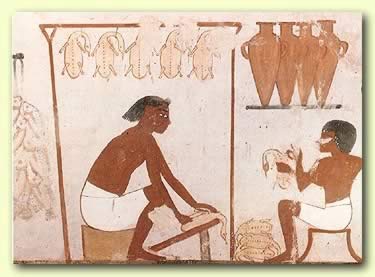 An unfortunate element of Egyptian education was that it was largely confined to boys. There were centers of education for men and father used to educate son. Egyptians did not regard education inevitable for women. The fundamentals of housekeeping, cooking, brewing and making clothes were taught to them.
An unfortunate element of Egyptian education was that it was largely confined to boys. There were centers of education for men and father used to educate son. Egyptians did not regard education inevitable for women. The fundamentals of housekeeping, cooking, brewing and making clothes were taught to them.
They were excluded both from temple elite and from working as scribes. Very few careers were open to most women. While most women trained for motherhood and on how to be a good wife, some girls could train to be dancers, entertainers, weavers, or bakers. Only the daughters of wealthy nobles received an education in reading or writing. The trades were hereditary. Sons followed the same occupation that their fathers practiced. Some children at this time attended a general village school while others attended a school designed for a specific career such as a priest or a scribe. The scribe schools were attended by boys on a daily basis. The teachers were experienced in government such as temple priests or scribes.
Ancient Egyptian Education
There was yet another school called the Prince’s school, the most respected of all schools. It educated the members of royal family, the Pharaoh’s sons, nobles and high officials.
Schools taught writing, reading, math, and sports as well as morals and manners. The lessons undertaken by the younger schoolboys consisted of basic mathematics and reciting sums. They used to practice by copying from existing ancient texts.
Young ones practiced writing on wooden tables, elder ones were given papyrus. Arithmetic and geometry, Reading and Writing, Music, Science, Geography, Medicine, Astronomy, and Math constituted the major lessons. Misdemeanours were treated seriously and pupils were punished.
Instruction of Wisdom
The higher level of education included learning what was called “Instruction of Wisdom” which included lessons on ethics and morality. The focus was to impart skills for higher status positions such as doctor or scribe. A man’s status in the society determined his son’s educational track
This higher level of education included learning what was called “Instruction of Wisdom.” The “Instruction of Wisdom” included lessons on ethics and morality. This higher level of education also focused on skills needed for higher status positions such as doctor or scribe.
The educational track that a student followed was typically determined by the position that the father held in society, yet, students who showed ability were able to receive training for higher status jobs.
Art of writing forms the crux of any educational system. Hieroglyphics was a system of pictures and symbols instead of words. It was a combination of logographic, syllabic, and alphabetic elements. The original hieroglyphs represented sounds and there were over 700 hieroglyphs which could be used in numerous combinations to give specific meanings.